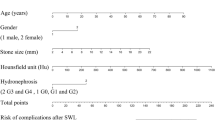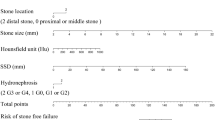Abstract
Objective
Infections in patients with kidney stones after extracorporeal shockwave lithotripsy (SWL) is a common clinical issue. However, the associated factors are unclear. Therefore, we aim to develop and validate a predictive model for infections after SWL in patients with kidney stone.
Methods
Between June 2020 and May 2022, consecutive kidney stone patients were enrolled. Of them, 553 patients comprised the development cohort. One hundred sixty-five patients comprised the validation cohort. The data were prospectively collected. The stepwise selection was applied using the likelihood ratio test with Akaike’s information criterion as the stopping rule; A predictive model was constructed through multivariate logistic regression. The performance was evaluated regarding discrimination, calibration, and clinical usefulness.
Results
Predictors of infections after SWL in treating kidney stones included older age (OR = 1.026, p = 0.041), female (OR = 2.066, p = 0.039), higher BMI (OR = 1.072, p = 0.039), lower stone density (OR = 0.995, p < 0.001), and higher grade of hydronephrosis (OR = 5.148, p < 0.001). For the validation cohort, the model showed good discrimination with an area under the receiver operating characteristic curve of 0.839 (95% CI 0.736, 0.941) and good calibration. Decision curve analysis demonstrated that the model was also clinically useful.
Conclusion
This study indicated that age, gender, BMI, stone density, and hydronephrosis grade were significant predictors of infections after SWL in treating kidney stones. It provided evidence in optimizing prevention and perioperative treatment strategies to reduce the risk of infection after SWL.

Similar content being viewed by others
Availability of data and materials
The datasets used and/or analyzed during the current study are available from the corresponding author upon reasonable request.
References
Wang W, Fan J, Huang G, Li J, Zhu X, Tian Y, Su L (2017) Prevalence of kidney stones in mainland China: a systematic review. Sci Rep. https://doi.org/10.1038/srep41630
Khan SR, Pearle MS, Robertson WG, Gambaro G, Canales BK, Doizi S, Traxer O, Tiselius HG (2016) Kidney stones. Nat Rev Dis Primers. https://doi.org/10.1038/nrdp.2016.8
Parr JM, Desai D, Winkle D (2015) Natural history and quality of life in patients with cystine urolithiasis: a single centre study. BJU Int 116(Suppl):331–335. https://doi.org/10.1111/bju.13169
Lawler AC, Ghiraldi EM, Tong C, Friedlander JI (2017) Extracorporeal shock wave therapy: current perspectives and future directions. Curr Urol Rep 18(4):25. https://doi.org/10.1007/s11934-017-0672-0
Junbo L, Yugen L, Guo J, Jing H, Ruichao Y, Tao W (2019) Retrograde intrarenal surgery vs. percutaneous nephrolithotomy vs. extracorporeal shock wave lithotripsy for lower pole renal stones 10–20 mm : a meta-analysis and systematic review. Urol J 16(2):97–106. https://doi.org/10.22037/uj.v0i0.4681
Dhar NB, Thornton J, Karafa MT, Streem SB (2004) A multivariate analysis of risk factors associated with subcapsular hematoma formation following electromagnetic shock wave lithotripsy. J Urol 172(6 Pt 1):2271–2274. https://doi.org/10.1097/01.ju.0000143459.03836.2d
Skolarikos A, Alivizatos G, de la Rosette J (2006) Extracorporeal shock wave lithotripsy 25 years later: complications and their prevention. Eur Urol 50(5):981–990; discussion 990. https://doi.org/10.1016/j.eururo.2006.01.045
Dreger NM, Degener S, Ahmad-Nejad P, Wöbker G, Roth S (2015) Urosepsis—etiology, diagnosis, and treatment. Dtsch Arztebl Int 112(49):837–847; quiz 848. https://doi.org/10.3238/arztebl.2015.0837
El-Nahas AR, Taha DE, Elsaadany MM, Zahran MH, Hassan M, Sheir KZ (2018) Hospital admission for treatment of complications after extracorporeal shock wave lithotripsy for renal stones: a study of risk factors. Urolithiasis 46(3):291–296. https://doi.org/10.1007/s00240-017-0983-0
Collins GS, Reitsma JB, Altman DG, Moons KG (2015) Transparent reporting of a multivariable prediction model for individual prognosis or diagnosis (TRIPOD): the TRIPOD statement. BMJ. https://doi.org/10.1136/bmj.g7594
Sauerbrei W, Boulesteix AL, Binder H (2011) Stability investigations of multivariable regression models derived from low- and high-dimensional data. J Biopharm Stat 21(6):1206–1231. https://doi.org/10.1080/10543406.2011.629890
Alhabeeb H, Baradwan S, Kord-Varkaneh H, Tan SC, Low TY, Alomar O, Salem H, Al-Badawi IA, Abu-Zaid A (2021) Association between body mass index and urinary tract infection: a systematic review and meta-analysis of observational cohort studies. Eat Weight Disord 26(7):2117–2125. https://doi.org/10.1007/s40519-020-01101-4
Milner JJ, Beck MA (2012) The impact of obesity on the immune response to infection. Proc Nutr Soc 71(2):298–306. https://doi.org/10.1017/s0029665112000158
Kim KY, Kim JK, Han SH, Lim JS, Kim KI, Cho DH, Lee MS, Lee JH, Yoon DY, Yoon SR, Chung JW, Choi I, Kim E, Yang Y (2006) Adiponectin is a negative regulator of NK cell cytotoxicity. J Immunol 176(10):5958–5964. https://doi.org/10.4049/jimmunol.176.10.5958
Pedersen BK, Febbraio MA (2012) Muscles, exercise and obesity: skeletal muscle as a secretory organ. Nat Rev Endocrinol 8(8):457–465. https://doi.org/10.1038/nrendo.2012.49
Muller LM, Gorter KJ, Hak E, Goudzwaard WL, Schellevis FG, Hoepelman AI, Rutten GE (2005) Increased risk of common infections in patients with type 1 and type 2 diabetes mellitus. Clin Infect Dis 41(3):281–288. https://doi.org/10.1086/431587
Cox CE, Hinman F, Jr (1961) Experiments with induced bacteriuria, vesical emptying and bacterial growth on the mechanism of bladder defense to infection. J Urol. https://doi.org/10.1016/s0022-5347(17)65257-1
Kitano H, Shigemoto N, Koba Y, Hara T, Seiya K, Omori K, Shigemura K, Teishima J, Fujisawa M, Matsubara A, Ohge H (2021) Indwelling catheterization, renal stones, and hydronephrosis are risk factors for symptomatic Staphylococcus aureus-related urinary tract infection. World J Urol 39(2):511–516. https://doi.org/10.1007/s00345-020-03223-x
Yongzhi L, Shi Y, Jia L, Yili L, Xingwang Z, Xue G (2018) Risk factors for urinary tract infection in patients with urolithiasis-primary report of a single center cohort. BMC Urol 18(1):45. https://doi.org/10.1186/s12894-018-0359-y
Bhojani N, Miller LE, Bhattacharyya S, Cutone B, Chew BH (2021) Risk factors for urosepsis after ureteroscopy for stone disease: a systematic review with meta-analysis. J Endourol 35(7):991–1000. https://doi.org/10.1089/end.2020.1133
Chen YZ, Lin WR, Lee CC, Sun FJ, Chow YC, Tsai WK, Chiang PK, Lin TP, Chen M, Chiu AW (2017) Comparison of safety and outcomes of shock wave lithotripsy between elderly and non-elderly patients. Clin Interv Aging. https://doi.org/10.2147/cia.S134750
Acknowledgements
We give special thanks to all our colleagues at the Department of Urology of Shengjing Hospital for their help and support. The authors would like to thank all of the study participants.
Funding
This study was financially supported by The 345 Talent Project of Shengjing Hospital, the Natural Science Foundation of Liaoning Science and Technology Department (Grant No. 2020-BS-093), and the Natural Science Foundation of Liaoning Education Department (Grant No. QN2019013). These sponsors had no role in the study design; in the collection, analysis, or interpretation of data; in the report's writing; or in the decision to submit the article for publication.
Author information
Authors and Affiliations
Contributions
Song Bai, and Dongmei Liu had full access to all the data in the study and took responsibility for the integrity of the data and the accuracy of the data analysis. Song Bai, and Dongmei Liu: Protocol/project development. Bitian Liu, Shen Pan, Lu Wang, Song Bai, and Dongmei Liu: Data collection or management. Bitian Liu, Shen Pan, Lu Wang, Song Bai, and Dongmei Liu: Data analysis. Bitian Liu, Shen Pan, Lu Wang, and Dongmei Liu: Manuscript writing/editing/revision.
Corresponding authors
Ethics declarations
Conflict of interest
All authors have no competing interests.
Consent for publication
Informed consent from all eligible patients was obtained.
Ethics approval and consent to participate
Ethical approval (2020PS520K) was provided by the Institutional Research and Ethics Committee of the Shengjing Hospital Affiliated China Medical University. Informed consent was obtained from all eligible subjects. The clinical research registry UIN is ChiCTR2000033789. The study protocol conformed to the ethical guidelines of the 1975 Declaration of Helsinki.
Additional information
Publisher's Note
Springer Nature remains neutral with regard to jurisdictional claims in published maps and institutional affiliations.
Supplementary Information
Below is the link to the electronic supplementary material.
Rights and permissions
Springer Nature or its licensor (e.g. a society or other partner) holds exclusive rights to this article under a publishing agreement with the author(s) or other rightsholder(s); author self-archiving of the accepted manuscript version of this article is solely governed by the terms of such publishing agreement and applicable law.
About this article
Cite this article
Liu, B., Pan, S., Wang, L. et al. Predictive markers for infections after extracorporeal shockwave lithotripsy in patients with kidney stone based on a large prospective cohort. World J Urol 42, 63 (2024). https://doi.org/10.1007/s00345-024-04769-w
Received:
Accepted:
Published:
DOI: https://doi.org/10.1007/s00345-024-04769-w




